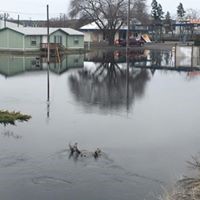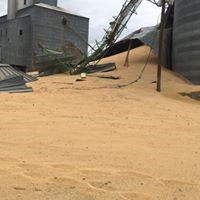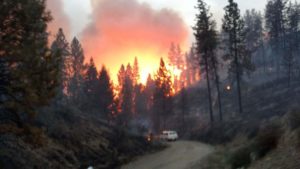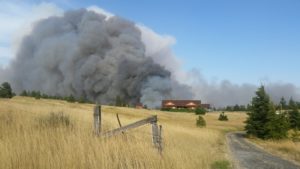
As the Lincoln County Emergency Management Director, it is the responsibility of the Sheriff to plan and direct disaster response or crisis management activities, provide disaster preparedness training, and prepare emergency plans and procedures for natural (e.g., hurricanes, floods, earthquakes), wartime, or technological (e.g., nuclear power plant emergencies or hazardous materials spills) disasters or hostage situations. The Sheriff coordinates and facilitates incident management and emergency preparedness in Lincoln County. He collaborates with private and public agencies, neighboring counties, emergency response agencies and elected officials to effectively respond to incidents. Below are the Lincoln County Emergency Management Plans.
Comprehensive Emergency Management Plan
The mission of the Lincoln County Department of Emergency Management is to
coordinate activities and programs to save lives, prevent injury, and protect property and the environment by taking reasonable and affordable actions to mitigate, prepare for, respond to, and recover from emergencies and disasters.
The purpose of this plan is to guide the Lincoln County Department of Emergency
Management in its responsibility to preserve lives, protect property and the
environment, and to ensure public health in times of natural or technological disasters.
The organization also provides for the coordination of recovery efforts following
disasters, and will provide actions to mitigate the effects of such disasters, to the
extent possible.
The Lincoln County CEMP uses the National Incident Management System (NIMS)
and is an all-hazards plan that provides the structure and mechanisms for policy and operational coordination for incident management. Consistent with the model provided in the National Response Framework (NRF) and NIMS, the CEMP can be partially or fully implemented in the context of a threat, or anticipation of or response to a significant incident or event. Selective implementation through the activation of one or more of the Emergency Support Functions (ESFs) or Annexes allows maximum flexibility in responding to and recovering from an incident, meeting the unique operational and information-sharing requirements of the situation at hand, and enabling effective interaction between various county and non-county entities. This plan will facilitate restoration of basic county government operations and services following emergencies or disasters.
This Comprehensive Emergency Management Plan is required by law and is the basis for an integrated system of Emergency Management in Lincoln County, in accordance with the requirements of Chapter 38.52 Revised Code of Washington.
Lincoln-County-CEMP-2018
Community Wildfire Protection Plan
The process of developing a Community Wildfire Protection Plan (CWPP) can help a community clarify and refine its priorities for the protection of life, property, and critical infrastructure in the wildland–urban interface on both public and private land. It also can lead community members through valuable discussions regarding management options and implications for the surrounding land base. Local fire service organizations help define issues that may place the county, communities, and/or individual homes at risk. Through the collaboration process, the CWPP steering committee discusses potential solutions, funding opportunities, and regulatory concerns and documents their resulting recommendations in the CWPP. The CWPP planning process also incorporates an element for public outreach. Public involvement in the development of the document not only facilitates public input and recommendations, but also provides an educational opportunity through interaction of local wildfire specialists and an interested public.
The idea for community-based wildland fire planning and prioritization is neither novel nor new. However, the incentive for communities to engage in comprehensive forest planning and prioritization was given new and unprecedented impetus with the enactment of the Healthy Forests Restoration Act (HFRA) in 2003. This landmark legislation includes the first meaningful statutory incentives for the US Forest Service (USFS) and the Bureau of Land Management (BLM) to give consideration to the priorities of local communities as they develop and implement forest management and hazardous fuel reduction projects. In order for a community to take full advantage of this new opportunity, it must first prepare a Community Wildfire Protection Plan(CWPP).
CWPP
Multi-Hazard Mitigation Plan
The purpose of the Comprehensive Emergency Management Plan (CEMP) is to guide The Lincoln County Department of Emergency Management in its responsibility to preserve lives, protect property and the environment, and to ensure public health in times of natural or technological disasters. The organization also provides for the coordination of recovery efforts following disasters, and will provide actions to mitigate the effects of such disasters, to the extent possible. The CEMP is an all hazard plan that is promulgated by Lincoln County Board of Commissioners and Mayors of the participating cities and towns within the county and applies to all local public and private entities and organizations participating and included in the plan. plan. The CEMP is an all hazard approach to emergency and disaster situations likely to occur in the county, as described in the Lincoln County Hazard Identification/Vulnerability Analysis (HIVA), and provides the foundation for:
- The establishment of an organization and guidelines for efficient and effective use of government, private sector and volunteer resources.
- An outline of local government responsibilities in emergency management activities as described under RCW 38.52 and other applicable laws.
- An outline of other participants’ responsibilities in emergency management activities as agreed upon by the participating agencies and organizations.
Final_Lincoln 2019_HMP
Final_Lincoln 2019_HMP












